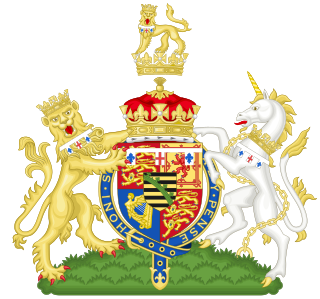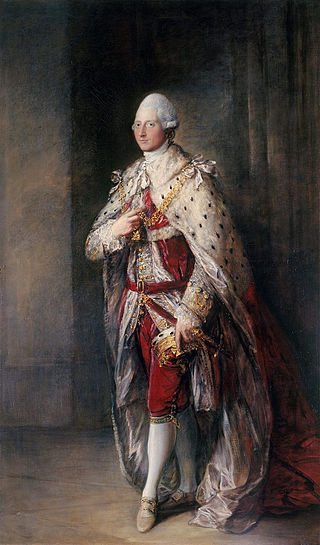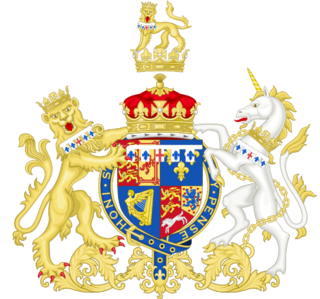Related Research Articles
Duke of Newcastle upon Tyne was a title that was created three times, once in the Peerage of England and twice in the Peerage of Great Britain. The first grant of the title was made in 1665 to William Cavendish, 1st Marquess of Newcastle upon Tyne. He was a prominent Royalist commander during the Civil War.

Duke of York is a title of nobility in the Peerage of the United Kingdom. Since the 15th century, it has, when granted, usually been given to the second son of English monarchs. The equivalent title in the Scottish peerage was Duke of Albany. However, King George II and King George III granted the titles Duke of York and Albany.

The House of Hanover, whose members are known as Hanoverians, is a European royal house of German origin that ruled Hanover, Great Britain, and Ireland at various times during the 17th to 20th centuries. The house originated in 1635 as a cadet branch of the House of Brunswick-Lüneburg, growing in prestige until Hanover became an Electorate in 1692. A great-grandson of King James VI and I, George I, who was prince-elector of Hanover, became the first Hanoverian monarch of Great Britain and Ireland in 1714. At the end of his line, Queen Victoria's death in 1901, the throne of the United Kingdom passed to her eldest son Edward VII, a member of the House of Saxe-Coburg and Gotha, through his father Albert, Prince Consort. The last reigning members of the House of Hanover lost the Duchy of Brunswick in 1918 when Germany became a republic.

Prince Edward, Duke of Kent and Strathearn, was the fourth son and fifth child of King George III. His only child, Victoria, became Queen of the United Kingdom 17 years after his death.

Duke of Connaught and Strathearn was a title in the Peerage of the United Kingdom that was granted on 24 May 1874 by Queen Victoria of the United Kingdom of Great Britain and Ireland to her third son, Prince Arthur. At the same time, he was also granted the subsidiary title of Earl of Sussex.

Prince Henry, Duke of Cumberland and Strathearn was the sixth child and fourth son of Frederick, Prince of Wales, and Princess Augusta of Saxe-Gotha, and a younger brother of George III. His 1771 marriage to a commoner against the King's wishes prompted the Royal Marriages Act 1772.

Duke of Kent is a title that has been created several times in the peerages of Great Britain and the United Kingdom, most recently as a royal dukedom for the fourth son of King George V. Since 1942, the title has been held by Prince Edward, Queen Elizabeth II's cousin.

The title of Earl of Athlone has been created three times.
Duke of Cumberland is a peerage title that was conferred upon junior members of the British royal family, named after the historic county of Cumberland.

Duke of Fife is a title in the Peerage of the United Kingdom that has been created twice, in both cases for Alexander Duff, 1st Duke of Fife and 6th Earl Fife, who in 1889 married Princess Louise, the eldest daughter of Albert Edward, Prince of Wales. The dukedom of Fife was created for a member of the British royal family by marriage, since the first holder's wife was a granddaughter of Queen Victoria.

Earl of Gosford is a title in the Peerage of Ireland. It was created in 1806 for Arthur Acheson, 2nd Viscount Gosford.

Baron Ellenborough, of Ellenborough in the County of Cumberland, is a title in the Peerage of the United Kingdom. It was created on 19 April 1802 for the lawyer, judge and politician Sir Edward Law, Lord Chief Justice of the King's Bench from 1802 to 1818. His son, the second Baron, notably served as Governor-General of India. On 22 October 1844 the second Baron was created Viscount Southam, of Southam in the County of Gloucester, and Earl of Ellenborough, in the County of Cumberland. These titles were also in the Peerage of the United Kingdom. His only son predeceased him and on his death in 1871 the viscountcy and earldom became extinct.

Duchess of Kent is the principal courtesy title used by the wife of the Duke of Kent. There have been four titles referring to Kent since the 18th century. The current duchess is Katharine, the wife of Prince Edward. He inherited the dukedom on 25 August 1942 upon the death of his father, Prince George, the fourth son of George V.

Earl Fife was a title in the Peerage of Ireland created by letters patent dated 26 April 1759 for William Duff, 1st Baron Braco, after asserting his descent from Macduff, the medieval Earl of Fife. Though in the Irish peerage, the title's name refers to Fife in Scotland.

Duke of Cumberland and Strathearn was a title in the Peerage of Great Britain that was conferred upon a member of the British royal family. It was named after the county of Cumberland in England, and after Strathearn in Scotland.

Earl or Mormaer of Strathearn is a title of Scottish nobility, referring to the region of Strathearn in southern Perthshire. Of unknown origin, the mormaers are attested for the first time in a document perhaps dating to 1115. The first known mormaer, Malise I, is mentioned by Ailred of Rievaulx as leading native Scots in the company of King David at the Battle of the Standard, 1138. The last ruler of the Strathearn line was Malise, also Earl of Caithness and Orkney, who had his earldom forfeited by King Edward Balliol. In 1344 it was regranted by King David to Maurice de Moravia, a royal favourite who had a vague claim to the earldom as Malise's nephew and also stepfather.

Duke of Kent and Strathearn is a title that was created once in the Peerage of Great Britain.

St George's Chapel at Windsor Castle in England is a castle chapel built in the late-medieval Perpendicular Gothic style. It is a Royal Peculiar, and the Chapel of the Order of the Garter. St George's Chapel was founded in the 14th century by King Edward III and extensively enlarged in the late 15th century. It is located in the Lower Ward of the castle.
Since William the Conqueror claimed the English throne, succession has been determined by bequest, battle, primogeniture, and parliament.
References
- ↑ "No. 21018". The London Gazette . 11 September 1849. p. 2783.
- ↑ Cokayne, G. E. (1910), Gibbs, Vicary (ed.), The complete peerage of England, Scotland, Ireland, Great Britain and the United Kingdom, vol. 4, London: St Catherine's Press, pp. 451–452
- ↑ Weir, Alison (1996), Britain's Royal Families: The Complete Genealogy, Revised Edition, London: Random House, p. 319, ISBN 0-7126-7448-9